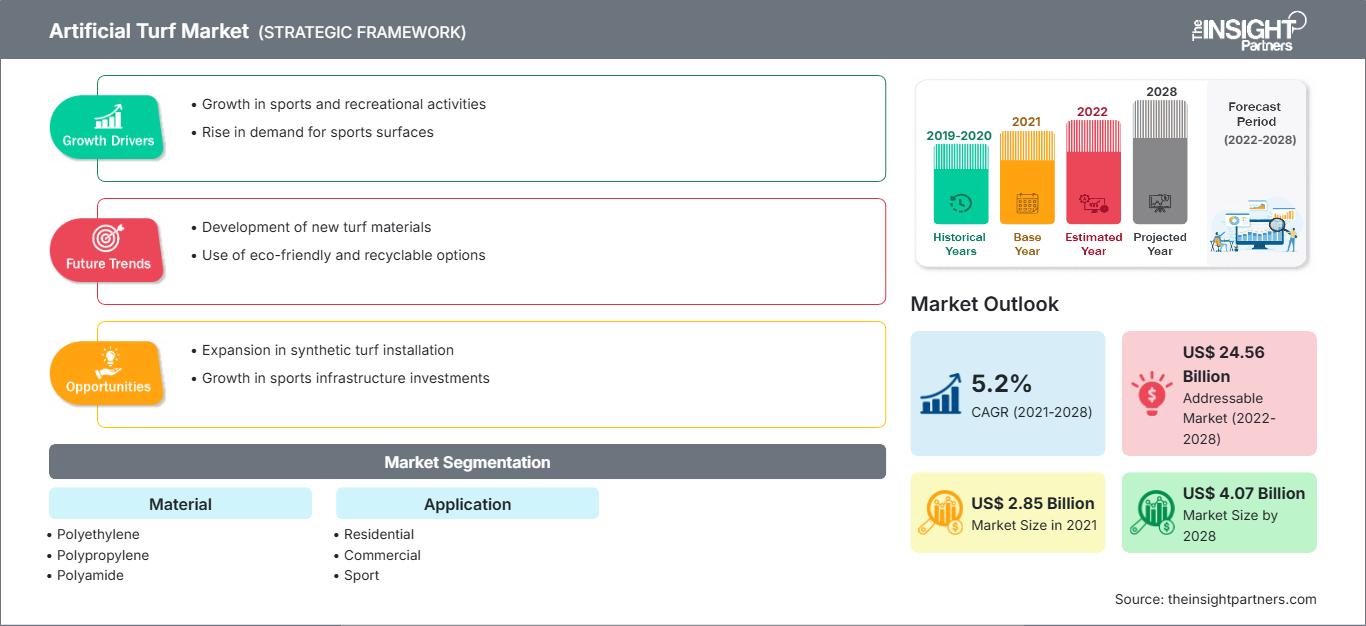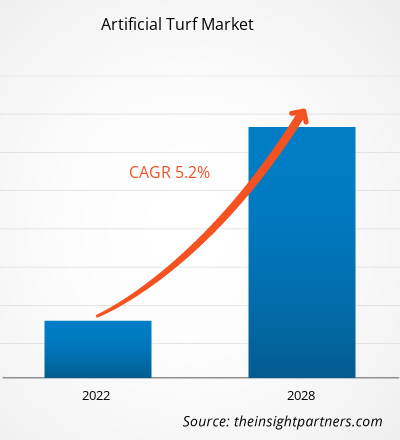Der Markt für Kunstrasen wurde im Jahr 2021 auf 2.847,28 Millionen US-Dollar geschätzt und soll bis 2028 4.067,36 Millionen US-Dollar erreichen. Von 2021 bis 2028 wird ein CAGR-Wachstum von 5,2 % erwartet.
Kunstrasen wird aus synthetischen Fasern hergestellt und imitiert Naturrasen. Zu den Rohstoffen für die Herstellung von Kunstrasen gehören Polyethylen (PE), Polypropylen (PP), Polyamid (Nylon), Gummimischungen, Polyesterschaum, verschiedene Farben und andere Zusatzstoffe. Die Qualität der Rohstoffe ist entscheidend für die Leistung des Rasens. Der globale Kunstrasenmarkt wird anhand von Material, Anwendung und Geografie analysiert. Im Jahr 2020 hatte der asiatisch-pazifische Raum den größten Umsatzanteil am globalen Kunstrasenmarkt. Der wichtigste Faktor für das Wachstum des Kunstrasenmarktes im asiatisch-pazifischen Raum ist die zunehmende Verwendung von Kunstrasen im Haushaltssektor. Die vielfältigen Vorteile von Kunstrasen, wie geringerer Wasser- und Chemikalienverbrauch, geringer Wartungsaufwand, keine Bewässerung und Witterungsbeständigkeit, tragen zu einer hohen Nachfrage nach Kunstrasen für Sportanlagen bei. Die zunehmende Globalisierung und das Wachstum der Bauindustrie begünstigen zudem das Wachstum des Kunstrasenmarktes. Darüber hinaus haben die Marktteilnehmer in der Region stark in Forschung und Entwicklung investiert und so zur Entwicklung innovativer Produkte beigetragen, was den regionalen Markt positiv beeinflusst.
Passen Sie diesen Bericht Ihren Anforderungen an
Sie erhalten kostenlos Anpassungen an jedem Bericht, einschließlich Teilen dieses Berichts oder einer Analyse auf Länderebene, eines Excel-Datenpakets sowie tolle Angebote und Rabatte für Start-ups und Universitäten.
Kunstrasenmarkt: Strategische Einblicke

-
Holen Sie sich die wichtigsten Markttrends aus diesem Bericht.Dieses KOSTENLOSE Beispiel umfasst Datenanalysen, die von Markttrends bis hin zu Schätzungen und Prognosen reichen.
Auswirkungen der COVID-19-Pandemie auf den Kunstrasenmarkt
Die COVID-19-Pandemie stellte viele Branchen, darunter die Chemie- und Werkstoffindustrie, vor beispiellose Herausforderungen. Aufgrund landesweiter Ausgangssperren und Grenzbeschränkungen wurden die Lieferketten vollständig unterbrochen. Dies beeinträchtigte die Produktion und den Vertrieb verschiedener Produkte. Viele Erholungsgebiete und Spielplätze wurden aufgrund des Virus geschlossen, was weltweit zu einem Anstieg der Heimwerkerarbeiten führte. Laut Synthetic Grass Warehouse verzeichnen Kunstrasenunternehmen Umsatzsteigerungen von bis zu 30 % gegenüber 2020. Sportplatzanwendungen machten 2020 63 % des verlegten Rasens aus und werden im Prognosezeitraum voraussichtlich der größte Anwendungsbereich bleiben. Rasen in der Landschaftsgestaltung verzeichnet jedoch ein rasantes Wachstum. In naher Zukunft dürften E-Commerce-Plattformen beim Verkauf verschiedener lebensnotwendiger und nicht lebensnotwendiger Güter, insbesondere Kunstrasen, deutlich an Dynamik gewinnen.
Markteinblicke
Steigende Nachfrage nach Kunstrasen aus der Sportbranche und zunehmende Anzahl von Stadien
Kunstrasen eignet sich für verschiedene Sportarten, wird aber üblicherweise für Baseball, Football, Lacrosse, Rugby und Fußball verwendet. Im Jahr 2021 entschied sich das Bank of America Stadium, von Naturrasen auf Kunstrasen umzusteigen. Tepper Sports & Entertainment kündigte an, vor der Saison 2021 der Carolina Panthers von Gras auf FieldTurf umzusteigen. Auch das BC Place Stadium in Kanada wird bis Ende Januar 2022 einen neuen Kunstrasenplatz haben. Darüber hinaus sind in Städten und Dörfern in Ländern wie Indien Kunstrasenplätze entstanden. Daher treiben die wachsende Nachfrage nach Kunstrasen in der Sportbranche und die zunehmende Anzahl von Stadien mit Kunstrasen den globalen Kunstrasenmarkt erheblich an.
Anwendungseinblicke
Basierend auf der Anwendung wurde der globale Kunstrasenmarkt in Wohn-, Gewerbe- und Sportbereiche segmentiert. Das Sportsegment hatte 2020 den größten Anteil am globalen Kunstrasenmarkt. Kunstrasen wird häufig auf Sportplätzen verwendet. Er wird hauptsächlich genutzt, um eine angemessene Oberfläche für Sportarten zu schaffen, die auf Gras in Bereichen gespielt werden, in denen die Pflege von Naturrasen schwierig ist oder dieser nicht wachsen kann. Die hohe Nachfrage nach Kunstrasen aus der Sportbranche ist hauptsächlich auf verschiedene Faktoren zurückzuführen, wie z. B. einfache Pflege, längere Spielzeit usw.
Einige der wichtigsten Akteure auf dem globalen Kunstrasenmarkt sind The Dow Chemical Company; Tarkett; Act Global; CCGrass; TenCate Grass; SIS Pitches; Victoria PLC; GreenFields BV; HATKO; und Hellas Construction, Inc. Diese Akteure konzentrieren sich bei ihrer Expansion hauptsächlich auf verschiedene Strategien, wie die Einführung neuer Produkte, Expansion sowie Fusionen und Übernahmen.
Kunstrasen
Regionale Einblicke in den Kunstrasenmarkt
Die Analysten von The Insight Partners haben die regionalen Trends und Faktoren, die den Kunstrasenmarkt im Prognosezeitraum beeinflussen, ausführlich erläutert. In diesem Abschnitt werden auch die Marktsegmente und die geografische Lage in Nordamerika, Europa, dem asiatisch-pazifischen Raum, dem Nahen Osten und Afrika sowie Süd- und Mittelamerika erörtert.
Umfang des Marktberichts über Kunstrasen
| Berichtsattribut | Einzelheiten |
|---|---|
| Marktgröße in 2021 | US$ 2.85 Billion |
| Marktgröße nach 2028 | US$ 4.07 Billion |
| Globale CAGR (2021 - 2028) | 5.2% |
| Historische Daten | 2019-2020 |
| Prognosezeitraum | 2022-2028 |
| Abgedeckte Segmente |
By Material
|
| Abgedeckte Regionen und Länder |
Nordamerika
|
| Marktführer und wichtige Unternehmensprofile |
|
Dichte der Akteure auf dem Kunstrasenmarkt: Auswirkungen auf die Geschäftsdynamik verstehen
Der Kunstrasenmarkt wächst rasant, angetrieben von der steigenden Endverbrauchernachfrage aufgrund von Faktoren wie sich entwickelnden Verbraucherpräferenzen, technologischem Fortschritt und einem stärkeren Bewusstsein für die Produktvorteile. Mit steigender Nachfrage erweitern Unternehmen ihr Angebot, entwickeln Innovationen, um den Verbraucherbedürfnissen gerecht zu werden, und nutzen neue Trends, was das Marktwachstum weiter ankurbelt.

- Holen Sie sich die Kunstrasenmarkt Übersicht der wichtigsten Akteure
Berichts-Spotlights
- Fortschreitende Branchentrends im Kunstrasenmarkt, um Akteuren bei der Entwicklung effektiver langfristiger Strategien zu helfen
- Geschäftswachstumsstrategien in entwickelten und sich entwickelnden Märkten
- Quantitative Analyse des Kunstrasenmarktes von 2019 bis 2028
- Schätzung der weltweiten Nachfrage nach Kunstrasen
- Porters Fünf-Kräfte-Analyse zur Veranschaulichung der Wirksamkeit von Käufern und Lieferanten in der Branche
- Jüngste Entwicklungen zum Verständnis des wettbewerbsorientierten Marktszenarios
- Markttrends und -aussichten sowie Faktoren, die das Wachstum des Kunstrasenmarktes vorantreiben und hemmen
- Unterstützung im Entscheidungsprozess durch Hervorhebung von Marktstrategien, die das kommerzielle Interesse untermauern und zum Marktwachstum führen
- Die Größe des Kunstrasenmarktes an verschiedenen Knotenpunkten
- Detaillierte Übersicht und Segmentierung des Marktes sowie der Kunstrasenbranche Dynamik
- Größe des Kunstrasenmarktes in verschiedenen Regionen mit vielversprechenden Wachstumschancen
Globaler Kunstrasenmarkt
Material
- Polyethylen
- Polypropylen
- Polyamid
- Sonstige
Anwendung
- Wohnbereich
- Gewerbe
- Sport
Firmenprofile
- The Dow Chemical Company
- Tarkett
- Act Global
- CCGrass
- TenCate Grass
- SIS Pitches
- Victoria PLC
- GreenFields BV
- HATKO
- Hellas Construction, Inc.
- Historische Analyse (2 Jahre), Basisjahr, Prognose (7 Jahre) mit CAGR
- PEST- und SWOT-Analyse
- Marktgröße Wert/Volumen – Global, Regional, Land
- Branchen- und Wettbewerbslandschaft
- Excel-Datensatz
Aktuelle Berichte
Erfahrungsberichte
Grund zum Kauf
- Fundierte Entscheidungsfindung
- Marktdynamik verstehen
- Wettbewerbsanalyse
- Kundeneinblicke
- Marktprognosen
- Risikominimierung
- Strategische Planung
- Investitionsbegründung
- Identifizierung neuer Märkte
- Verbesserung von Marketingstrategien
- Steigerung der Betriebseffizienz
- Anpassung an regulatorische Trends






















 Kostenlose Probe anfordern für - Kunstrasenmarkt
Kostenlose Probe anfordern für - Kunstrasenmarkt